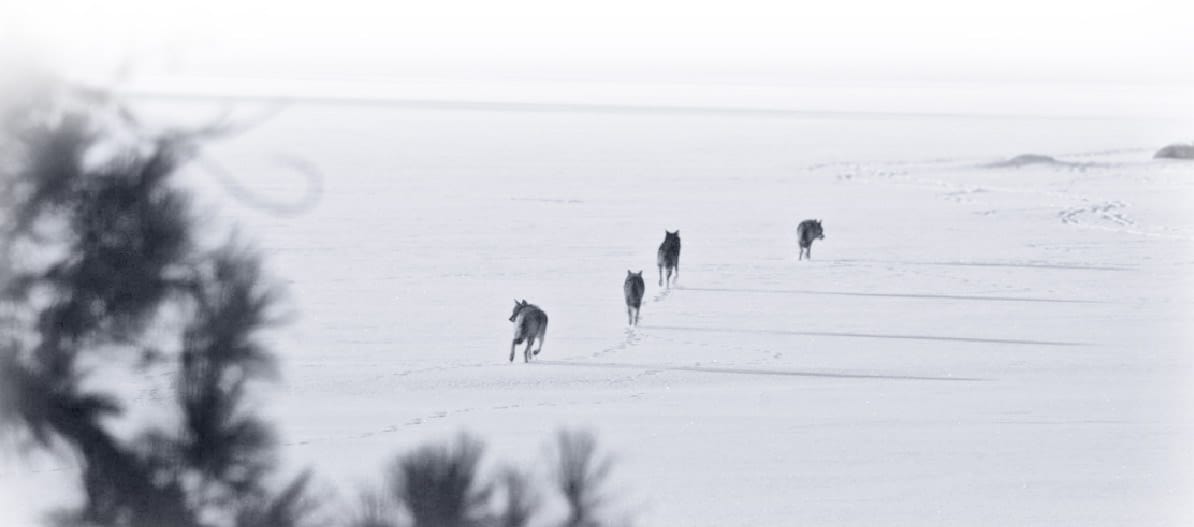by Paul Schurke
Ask most of us dogsledders and skiers about what we find so compelling about the Quetico Superior country in the snow season, and the answer is often the same: the wilderness is somehow wilder in winter.
Visitors are certainly less evident. Of the quarter million trekkers who visit the region annually, less than one percent ply its lakes and trails when they’re frozen and snow drifted. But its residents are vastly more evident. With the foliage gone, vistas into the forest are enhanced, along with prospects for spotting wildlife.
More significantly, even the critters that remain hidden can’t help but leave their calling cards behind. The vast networks of tracks that knit their way across the snowscape give hint not only of where the animals were headed, but sometimes even why. Consider this bit of track sleuthing that a friend and I found ourselves engaged in during a January dogsled and ski trek on the Kawishiwi River.
In the fleeting daylight of late afternoon, we found ourselves approaching a long set of rapids. The portage trail was deeply drifted over and in steep terrain—not a welcome prospect at day’s end. But with no suitable camp options nearby, we were obliged to push on.
Fortunately a ribbon of solid shelf ice extended along the rapids edge just wide enough for us to negotiate, and we threaded our way without mishap. At the rapids base, the gorge widened out into a catchment pool. There a curious feature caught our eyes. A perfect circle—a dozen yards in diameter—was rutted into the the thin snow on its surface. At its center a protrusion of some kind poked through the thin black ice like a bullseye.
This odd scene compelled investigation. We secured our dogteams along the shoreline and ventured out on skis. As we approached, the situation revealed itself. The circle was wolf tracks and the protrusion was a moose antler.
With a bit more sleuthing, the story became clear to us. Extending along the far shoreline and out towards the frozen pool was a braided set of wolf and moose tracks. The pack has pursued the moose to the base of the rapids where it had taken a chance to make the crossing. But the moose had miscalculated the ice and punched through.
Floundering in the deep water, he had flayed mightily with his front hooves in a desperate effort to gain purchase on the thin ice and pull himself out. But that only served to create an ever larger hole, and his terror was surely heightened by the the wolves that circled round and round awaiting their chance.
The drama may have played out for an hour or more. But in the end the moose succumbed. There he lay, floating at the center of the pool formed by his death throes.
The deeply-rutted track around the pool made it apparent that the wolf pack had continued to circle with persistence, hopeful their harvest would float within their reach. Given the freshness of their tracks, we surmised that their patience had been disrupted by the approach.
Destiny had laid claim to the moose. No amount of empathy would change that. But we felt a tinge of guilt for disrupting the wolves’ prospects for a meal. Ice was now reforming over the pool and the cold night ahead would render their meal inaccessible to them.
A solution presented itself. With a hatchet and long rope, I skied out to protruding antler and, after chopping an opening, looped the rope around it. Heading back to shore, I secured the free end to the upstanders of our dogsled. Would our dogs have the torque to break the moose free and tow him up onto the ice? Though it seemed unlikely, we added our muscle power to theirs by leaning into the back of the sled and encouraged them forward. The line snapped tight. Again we shouted “Hike!” The dogs lunged with more vigor. The moose broke free from its icey moorings and inched forward. Soon it was entirely on the surface. Young and robust, it clearly represented quite a prize for the wolf pack. And now it would be.
With twilight upon us, we set camp a quarter mile down stream. An hour later as the moon rose, we enjoyed our evening meal and looked upstream towards that pool to watch a silhouette of seven wolves feasting on theirs.
Paul Schurke operates Wintergreen Dogsled Lodge on White Iron Lake near Ely, Minnesota, and is a founding board member of the Northeastern Minnesotans for Wilderness.
Read more in Wilderness News Summer 2015


